SEPTEMBER 24, 2009
In this photo supplied by Petra Diamonds CEO Johan Dippenaar, holds the 507.55 carat white diamond recovered at the Cullinan Diamond Mine, South Africa, on Thursday Sept. 24, 2009. Petra Diamonds Ltd. says a diamond the size of a chicken egg has been found at South Africa's Cullinan mine. The diamond may be among the world's top 20 high-quality gems. It was discovered at the mine northeast of Pretoria, South Africa. (AP Photo/Petra Diamonds)
DECEMBER 10, 2008
THE WITTELSBACH DIAMOND
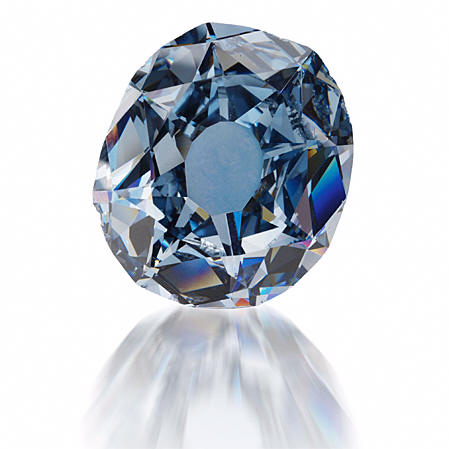
"In the midst
of these challenging times, we were thrilled to achieve an historic
price for an historic diamond. At $24.3 million, the 35.56ct
Wittelsbach blue diamond, dating to the 17th Century, has become the
most expensive diamond sold at auction, topping the previous record
of $16.5 million for a 100ct diamond in 1995 in Geneva. It was
purchased by the leading international jeweler Laurence Graff,
bidding against Aleks Paul of Essex Global Trading, a professional
of Russian origin based in New York.” said François Curiel, Chairman of
Christie's Europe and International Head of Jewelry.
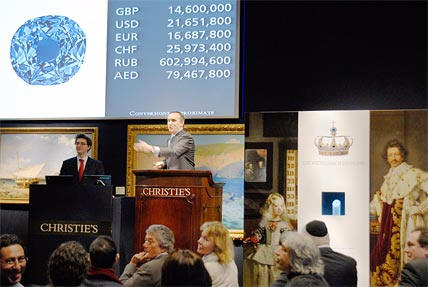
The Wittelsbach diamond is accompanied by a certificate from the Gemological Institute of America dated September 24th, 2008, indicating that the diamond is fancy deep grayish-blue, VS2 clarity.
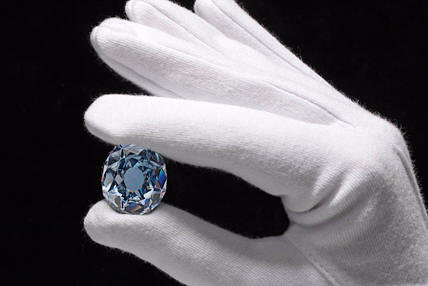 Origin
of the name
Origin
of the name
This rare blue diamond of Indian origin that has a recorded history dating back to the late 17th century, eventually came into the possession of the Wittelsbach family in 1722, the German noble family that provided rulers of Bavaria and of the Rhenish Palatinate until the 20th century. Bavaria was ruled for over 700 years by Dukes of the Wittelsbach family, from 1180 to 1918. The name Wittelsbach was taken from the Castle of Wittelsbach, which became the official residence of the Dukes of Bavaria. The diamond gets its name from the Wittelsbach family, in whose possession it remained as a family diamond until the abdication of the last king in 1918.
The Wittelsbach is a 35.56-carat, cushion-cut, dark blue diamond of fancy deep grayish-blue color and VS2 clarity. The diamond is also said to be pure apart from a few surface scratches. There are 82 facets on the diamond. The main facets on the crown are vertically split and the pavilion has 16 needle like facets arranged in pairs and radiating from the culet.
The Wittelsbach is the 3rd largest of the known famous blue diamonds in the world.
It is interesting to note that the first four largest blue diamonds are all historic diamonds of Indian origin, the original source of blue diamonds in the world. The remaining diamonds are all of South African origin.
The main source of blue diamonds in India, was the famous Kollur mines near Golconda, in Andhra Pradesh, in Southern India. The main source of blue diamonds in South Africa, is the De Beers Premier mines, in Transvaal, South Africa.
Another fact is the restricted size of blue diamonds. All the diamonds are below 50 carats in weight. In comparison yellow diamonds and colorless diamonds which are more predominant in nature have much larger carat weights. The 1st, 2nd, and 3rd largest colorless diamonds in the world the Cullinan I, Cullinan II, and the Centenary, have weights of 530.20 carats, 317.40 carats and 273.85 carats respectively. Likewise, the 1st, 2nd and 3rd largest yellow diamonds in the world, the Incomparable, the De Beers, and the Red Cross diamonds have weights of 407.48 carats, 234.65 carats, and 205.07 carats respectively. Thus it appears that in blue diamonds the rarity of the color is combined with the restricted size of the diamonds.
Being a blue diamond the Wittelsbach is a rare Type IIb diamond, which constitute only 0.1 % of all naturally occurring diamonds. Blue diamonds are Type II because they are nitrogen-free or contain undetectable quantities of nitrogen. They are Type IIb, because instead of nitrogen they contain trace quantities of another impurity boron, which imparts the blue color to the diamonds. Another feature of blue diamonds is, that unlike other diamonds which are non-conductors of electricity, blue diamonds are semi-conductors.
______________________________________________________________________________________________
SEPTEMBER 21, 2008
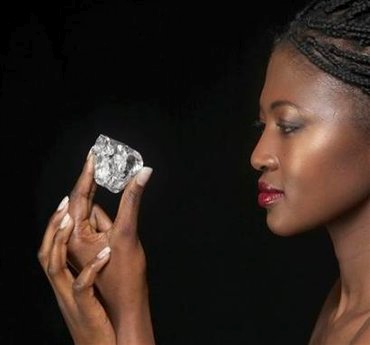
History was made over the weekend when a
monster diamond unearthed at the Letseng Mine in Africa was unveiled
to the world.
The diamond weighs in at 478 carats and is expected to become the
largest, most perfect round diamond in the world after cutting.
"Preliminary examination of this remarkable diamond indicates it will
yield a record-breaking polished stone of the very best color and
clarity," said company chief executive Clifford Elphick of Gem
Diamonds.
The diamond, which was discovered on
September 8 in Lesotho and is as yet unnamed, has the potential to
yield a 150 carat cut stone, and could sell for tens of millions of
dollars, the company said.
The mine, which was owned by De Beers for many years, has already
produced three of the world's biggest diamonds. These are the
603-carat Lesotho Promise, 493-carat Letseng Legacy and the 601-carat
Lesotho Brown.
Experts in Antwerp, Belgium, who analyzed the 478-carat stone
determined it to be of the highest color grading available for a white
diamond, said a statement from Gem Diamonds Ltd., the company that
found the stone.
"What makes it more remarkable is the color and quality of this
stone," said diamond consultant Neil Buxton, further stating that it
is a D color, which is highest possible graded color which could
produce over 100 carats.
It would be bigger than the 105 carat round-cut Koh-i-Noor diamond,
which is part of the British Crown Jewels.
It would still be dwarfed by the Cullinan diamond discovered in 1905, which was 3,106 carats uncut and yielded a teardrop shaped diamond of 530 carats called the Great Star of Africa.
The Letseng mine is owned by a mining
company of which Gem Diamonds controls 70% and the Lesotho government
controls 30%.

![]()
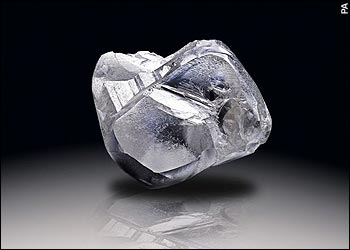
Close-up of the 478 carat rough from the Letseng Mine in Africa and
from the back